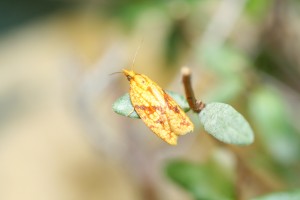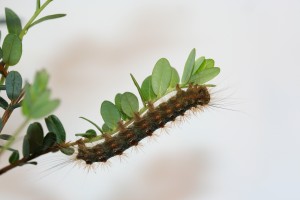If your beds have damage caused by root-feeding insects, you should consider treatment with Imidacloprid (e.g. Admire Pro, Alias 4F, Alias 2F) immediately after bees are removed. Occurrence of root-feeding insects will manifest by the presence of dead patches. Pull dead vines and search through the root zone and soil for grubs and worms. Admire Pro (imidacloprid) is labeled for the control of cranberry rootworm, white grubs (Phyllophaga spp.), and other scarabs in cranberries. [Read more…]
Beating the Bugs in the Bogs – Blunt-nosed Leafhopper
Blunt-nosed leafhopper is an important concern for cranberry, not because the insect causes that much feeding damage, but because it can transmit cranberry false blossom disease. False blossom is characterized by a malformation of the flowers. The flower pedicels become erect and there is no production of fruit, with devastating effects for cranberry yield. Blunt-nosed leafhopper nymphs start to occur in the bogs by the end of May, and adults reach their peak numbers in July. Relatively little is known about the way the insects transmit false blossom disease, and at the Cranberry & Blueberry Research Center, we soon hope to change that. [Read more…]
Post-bloom Insect Pest Control Recommendations
Sparganothis fruitworm (SPARG) – If your farm has high pheromone trap counts, you should consider managing this pest as soon as bees are removed. The timing for this 1st post-pollination spray is at 2 weeks after peak pheromone trap catches, which usually coincides with the second week in July. [Read more…]
Beating the Bugs in the Bogs – Gypsy Moth
Gypsy moth is an occasional pest of cranberries. Gypsy moth caterpillars will readily eat the plants in outbreak years, when they are abundant in the NJ Pinelands, like in 2007. They prefer to feed on oaks, but when they encounter cranberry plants, their presence can have a devastating effect. Fortunately, since 2007, the caterpillars have rarely been seen in the NJ Pinelands. However, this doesn’t mean we shouldn’t be prepared for their eventual return. Also, studying cranberry resistance against gypsy moth will teach us about the resistance of the plants against other important pests as well.
[Read more…]
Cranberry Insect IPM During Bloom
We are in the middle of bloom. If insects have been effectively managed prior to bloom, we recommend no sprays at this time. A reminder: when bees are present your only choices of insecticides are the Insect Growth Regulators –IGR- (e.g. Confirm and Intrepid) or Bt products (e.g. DiPel). [Read more…]
Cranberry Insect Upate
The season has started very slow due to the cold weather. Insect activity is just starting to increase. Thus, growers need to intensify their scouting efforts. The following insect pests bear special mention for early-season scouting:
Blackheaded fireworm – Blackheaded fireworm eggs overwinter on the bed and usually hatch by around mid-May. It is important to catch the first generation, if possible, because the second generation occurs during bloom and is typically much more destructive. Blackheaded fireworm larvae can be detected by sweep net sampling and it is good idea to look along the edges of bed where vines first begin to grow.
Remember: blackheaded fireworm is much easier to control if detected during the early part of the season. [Read more…]


